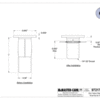OK it's slow on here so I'mma revive this thread to tell "The Rest Of The story."
As some of you know, Bridget and I made it to Carlisle, in the rain, no problem, and onto the field on Saturday. All this happened after I re-checked every wire I could see or touch on the car, found no signs of shorts, experienced yet more intermittent popping of that one 10 amp fuse in the IGN circuit and, finally (thinking I might have previously downgraded it from a higher amp model) "upgraded" it to a 15.
The wires leading to and from it were all 12s. A 15 amp fuse seemed to do the circuit no harm, and the fuse-blowout issue subsided completely.
So I drove to Carlisle, etc. Had a grand old time with my droogies in the pouring rain as per usual, and loaded the car on Sunday morning for the 70-ish mile trip home when:
Fuse blew. dang.

Replaced with the 15-amp breaker and....
The smoke escaped from the wires.
The car kept running but I shut her down right quick, as one does, reaching for the extinguisher. I could not see easily under and in where the trouble was, but surmised it was an O2 sensor, just by the position of the smoke.
So began a several-hour wait for AAA ("It's Mother's Day, can you wait until tomorrow for pickup?"). Luckily, @El Frazoo and the Drakes were hanging around;

Cory offered to get his hauler and store Bridget at his place before the tow company dispatched a motherless old driver for the gig.

That's Ed. Cool guy, good driver. Once home I rolled her on the lift. The culprit was easy to see then:

That's the proximity switch I'd installed after breaking the old on during the trailing arm job last winter. It's supposed to work as a Vehicle Speed Sensor, sending the ECU a 5v blip of energy five times per wheel revolution. Bench tested fine, the little red indicator flashing as it should.
But internally it appears to have been flawed. Which is why I could not find the trouble.
And the car runs fine without it. In fact, it's apparent to me that the previous iteration was also not working. The symptom: Bridget sometimes stalls out for a second on the highway, when she's been traveling steady for an hour or more. The first time this happened I was in the left lane on the Baltimore Washington Parkway shortly after completing the engine swap, a decade ago. Engine cut out at 70 mph. Just about crapped my pants and frantically sawed the wheel to get over to the breakdown lane. Trucks whizzing by, misery. Then realized she was idling as normal. Revved a couple times. Shrugged and cracked on.
Learned to live with it: every so often, she hiccups. Engine cuts out for about one second, then regains its rhythm and on you crack.
This, apparently, is what happens when the VSS malfunctions in a 1995 Subaru.
And so it goes. I will continue to research a fix for this, but I will not be trying to make this type of proximity switch (which is better suited to 3d printers) work in my application.











